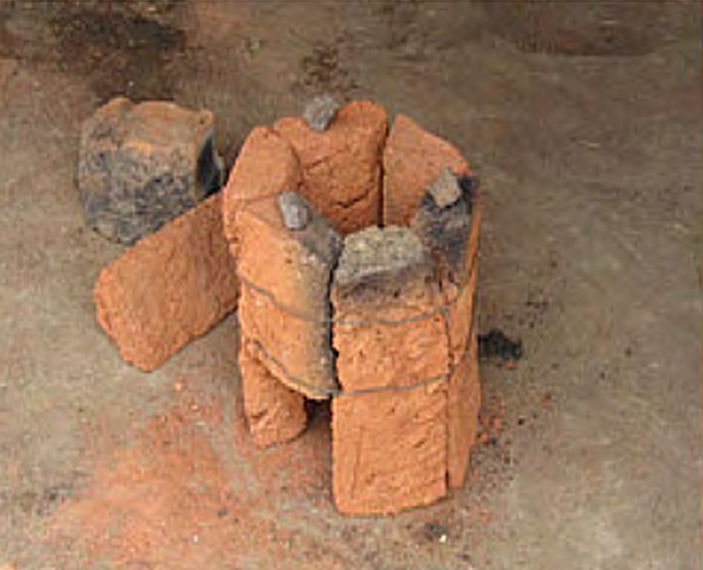
In relatively prosperous lands, buildings are constructed of such materials as concrete, steel, and wood.
In many lands, however, such materials are out of reach. Less expensive materials must be used, especially for housing.
Brick masonry is a logical choice. In the arts, dung may be added to clay without the straw in the manufacture of pottery. What’s the chemical background of this technique?
Bricks: Early Origins
Baked bricks were used even in early Bible accounts. Genesis 11:3 quotes individuals crossing the valley plain of Shinar: “And they began to say, each one to the other: “Come on! Let us make bricks and bake them with a burning process.” So brick served as stone for them, but bitumen served as mortar for them.”
The bricks in this account were baked with a burning process. Such a process consumes energy, and hence raw materials. It also produces pollution and costs money.
For this reason (cost likely being more of a consideration than pollution) much of the brick produced from clay, dung, and straw in less affluent lands is merely sun-dried, and not fired in any fashion.
Enjoy this video, less than one minute long, on how these bricks are made…
Chemistry of Clay, Straw, and Dung: The Important Question
Why is it beneficial to employ all three of these ingredients, rather than simply use just the readily available clay? For one thing, adding dung to clay tempers the clay, increasing the material’s plasticity – it reduces the clay’s tendency toward major cracking. If fired, the consumed fiber material, whether straw or grass, leaves internal voids that lighten the bricks and improve their thermal properties.
To quote the book Pottery-making Cultures and Indian Civilization, “The quality of clay is also improved by adding…ash, sand, and cattle dung. The temper counteracts excessive shrinking, warping, or splitting that may occur in sun-drying and firing.”
So the addition of cow dung is advisable – but not in too large a quantity, because if too much is used, the clay loses its adhesion, and won’t stick as well.
But Why?
The chemistry between clay and dung, as might be imagined, is complex. However, one study reports that as dung is added, the pH of the mix increases, while the acidity of the clay decreases. The property of pH refers to the concentration of hydrogen ions in solution. Zero is strongly acid, seven neither acidic or basic, and 14 is strongly basic. Vinegar is a common acid, and washing soda is a common base.
Exactly why this increase in pH should result in improved properties by an appropriate blend of the two ingredients is not immediately apparent. There is a strong possibility that another mechanism is at work.
The clay may crack upon drying or being fired due in part to uneven moisture distribution, or overly rapid surface drying. Heating reduces clay particle adhesion, and increases the likelihood stresses induced by uneven moisture distribution may suffice to induce cracking.
As early as 1836, an article in The Journal of the Franklin Institute of the State of Pennsylvania concluded it was the “viscous liquor” (moisture made less volatile by dissolved substances) found within the dung that prevented a too-rapid loss of moisture from the clay objects being fired (or dried).
Dung in Bricks: Evaluation
Although one may expect research to move forward as to the combining of clay and dung (and perhaps other materials) in the construction trade, it may be that not a single factor, but multiple factors contribute to the symbiotic use of these two ingredients. Controlled moisture release may be coupled with chemical combination (acid-base related) and even some additional process, producing the satisfactory result, rather than only one factor being responsible.
Note: You might also enjoy Cement Production Aggravates Carbon Dioxide Levels
References:
- Katale, D. P.: Investigation on the Use of Clayey Soil Mixed with Cow Dung to Produce Sustainable Bricks
- JSTOR: Dung Tempered Clay
- Cow-Dung “Ziballa”: The Best Additive to Brick Clays (based on research in Sudan)
- Saraswati, Baidyanath.: Pottery-making Cultures and Indian Civilization . Google Books
- Ewulo, B. S.: Effect of Poultry Dung and Cattle manure on Chemical Properties of Clay and Sandy Clay Loam Soil . Research Gate
- Frog Pond Pottery: Cracking and Warping – The Plague of (Nearly) Every Potter
- Jones, MD, Thomas P.: How dung reduces clay cracking. (1836). Journal of the Franklin Institute of the State of Pennsylvania
- African Rural Development & Sustainability Organization: Rocket Stoves: Small Solution with a Big Impact

Interesting. There is a place in Ireland that teaches you how to make cobh buildings – made from mud. These are really beautiful and I would love to have a go at it. This uses mud over a framework, rather than bricks.